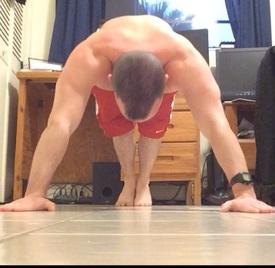Stronglifts 5x5 really build muscle???
Replies
-
This bit here from the intro to Layne's PHAT program has informed all of my training since:
"Most people try to make these issues out to be black and white to solidify their stances and often fail to acknowledge that these issues are not black and white and there is a substantial gray area. Take the arguments regarding rep ranges for example. How often have you heard you should ONLY train in ‘X’ rep range because it is the best one for growth. Then two days later you see an article interviewing a 300 lb behemoth who trains in a different rep range but also looks insane, so who are you to believe?"
I've said before that I made the decision to listen to Layne a while ago. I like what he claims is important to him, and I like his approach. In an industry where there's always the risk of someone being a fraud, he seems the most credible given his university degrees, academic research, and bodybuilding/powerlifting chops.
His stance... the answer falls in the grey area in between. Train both. Done. Works for me. It's also backed up by others I look up to like Wendler.
Great point. I'm going to continue to train both going forward.
Brad Shoenfeld is another expert in the field that you might want to do some research on.
http://www.t-nation.com/training/light-weights-for-big-gains/printMultiple Rep Ranges Means Maximal Stimulation
For those who want to maximize their hypertrophic potential, it makes sense to train across the continuum of repetition ranges. While there may be validity to focusing on the so-called "hypertrophy range" (6-12 reps), both high (15-20+) and low (1-5) repetition ranges should also be incorporated into your training program.
Not only does such an approach ensure full stimulation of the spectrum of muscle fibers, but it also serves as preparatory work for optimizing performance in the hypertrophy range. Low rep work enhances neuromuscular adaptations necessary for the development of maximal strength so that heavier loads (and thereby greater mechanical tension) can be used at moderate training intensities.
Conversely, performance of higher-rep sets help over time to raise lactate threshold, staving off the onset of fatigue and thus increasing time-under-tension during moderate-rep training.
There are infinite ways in which varied intensities can be integrated into program design. Perhaps the best way to ensure continued progress is by periodizing training rep ranges over time. Both linear and non-linear models are viable alternatives here. It really comes down to personal preference as well as individual goals (i.e., whether you're looking to peak for a specific event).
Another option is to base loading strategies on the type of exercise performed. You might decide to focus on low to moderate-reps (~1-10) for multi-joint movements such as squats, rows, and presses while prioritizing higher rep training (15+) for single-joint, isolation type exercises that may be better suited to lighter training loads.
There are no hard-and-fast rules here. The response to training varies by the individual and ultimately you need to experiment with different approaches and find out what works best.
The whole article is good. I just quoted one section of it.0 -
Yep, I believe in hybrid routines. PHUL is just Layne Norton's PHAT in 4 days instead of two. Pretty cool.
Personally I'm doing a variant of 5/3/1, where I use the compound movements for strength, and the rest of my work is for hypertrophy.
That sounds like a good idea. I've not wanted to run the 5/3/1 program because I don't have the interest in going anywhere below 3-4 reps but doing it and following up with hypertrophy might be good. I guy here at work is new to lifting and he is starting with old Beyond 5/3/1.
Why not below 4 reps?
It just seems to me to be away from my overall goals. And that can just the hypertrophic talk coming out of me. 4-6 when I'm focusing on strength just seems like spot for me. I'm open to going lower at some point.
Of course they are your goals, but keep in mind that 5/3/1 is designed for strength gains, and it is definitely a better program for long term strength gains than SL5x5. SL 5x5 is great for beginners to get them used to heavy weight, teach the importance of the big movements, and fast incrementing from the bar (which is good for avoiding injury), but it's not a long term program like 5/3/1 and it has you working in the lower end of the rep range for a reason. Once you start approaching your current strength maxes, a 5x5 just won't work for you.0 -
You're forgetting the fact that a calorie surplus will help you gain muscle on top of training. At 2200 calories, about 6'0 no gains will be made bro.0
-
In...
...because this discussion is relevant to my interests.
Me too.0 -
Both will build size as well as strength. I seriously doubt you would be able to tell the difference in size gain between the two routines as a new lifter. All other things being the same.
The program you are on is a great one though. If you like it there is really no need to switch unless you just want to try out other programs.
Personally I like routines with periodization built in. Working across multiple rep ranges is more enjoyable for me but my main goal is not power lifting either.
I'm thinking the same thing. I looked at Layne Norton's PHAT but I like the 2 on 1 off 2 on 2 off approach of Brandon's workout. I may be sticking to it. I wanted to see what others thought of the StrongLifts 5x5 claim's of muscle gains with his program. Plus I'm not sure I can handle squating heavy three days a week.
You're not eating enough, then.0 -
Both will build size as well as strength. I seriously doubt you would be able to tell the difference in size gain between the two routines as a new lifter. All other things being the same.
The program you are on is a great one though. If you like it there is really no need to switch unless you just want to try out other programs.
Personally I like routines with periodization built in. Working across multiple rep ranges is more enjoyable for me but my main goal is not power lifting either.
I'm thinking the same thing. I looked at Layne Norton's PHAT but I like the 2 on 1 off 2 on 2 off approach of Brandon's workout. I may be sticking to it. I wanted to see what others thought of the StrongLifts 5x5 claim's of muscle gains with his program. Plus I'm not sure I can handle squating heavy three days a week.
You're not eating enough, then.
I know I'm not eating enough for it. I'm trying to find out what my true maintainance calories are right now. Most formulas say 2500-2800. I'm going up to that to see when I gain a pound. This week 2500 calories. I'm enjoying the extra calories.0 -
You're forgetting the fact that a calorie surplus will help you gain muscle on top of training. At 2200 calories, about 6'0 no gains will be made bro.
I'm not trying to gain right now. I'm trying to find out what is the most calories I can eat to maintain my current weight. I have been eating at a low amount of calories for so long that I don't know what my maintainance is. This week i'm eating 2500. Didn't gain last week at 2250.0 -
Both will build size as well as strength. I seriously doubt you would be able to tell the difference in size gain between the two routines as a new lifter. All other things being the same.
The program you are on is a great one though. If you like it there is really no need to switch unless you just want to try out other programs.
Personally I like routines with periodization built in. Working across multiple rep ranges is more enjoyable for me but my main goal is not power lifting either.
I'm thinking the same thing. I looked at Layne Norton's PHAT but I like the 2 on 1 off 2 on 2 off approach of Brandon's workout. I may be sticking to it. I wanted to see what others thought of the StrongLifts 5x5 claim's of muscle gains with his program. Plus I'm not sure I can handle squating heavy three days a week.
You're not eating enough, then.
I know I'm not eating enough for it. I'm trying to find out what my true maintainance calories are right now. Most formulas say 2500-2800. I'm going up to that to see when I gain a pound. This week 2500 calories. I'm enjoying the extra calories.
I'm saying you're really not eating enough if you can't squat heavy 3x a week. People do it for months on end in a deficit. You're not going to catch "the overtraining."0 -
I’ve been working out for years and realized that I could be getting so much more out of it. I was wondering why I wasn’t gaining any more muscle. I did some research and found a system that can take scrawny to brawny. It has everything you need to succeed like I did. I found out I wasn’t getting enough protein and was working out too long. Now, I have more time to do other things. Go to http://buildthemuscle.net. And get guaranteed results. Good luck!0
This discussion has been closed.
Categories
- All Categories
- 1.4M Health, Wellness and Goals
- 398.2K Introduce Yourself
- 44.7K Getting Started
- 261K Health and Weight Loss
- 176.4K Food and Nutrition
- 47.7K Recipes
- 233K Fitness and Exercise
- 462 Sleep, Mindfulness and Overall Wellness
- 6.5K Goal: Maintaining Weight
- 8.7K Goal: Gaining Weight and Body Building
- 153.5K Motivation and Support
- 8.4K Challenges
- 1.4K Debate Club
- 96.5K Chit-Chat
- 2.6K Fun and Games
- 4.8K MyFitnessPal Information
- 12 News and Announcements
- 21 MyFitnessPal Academy
- 1.6K Feature Suggestions and Ideas
- 3.2K MyFitnessPal Tech Support Questions






